Question: I’m an amateur barrel racer and compete on my 8-year-old Quarter Horse gelding. By spring, he’ll have been off work for about five months. How should I go about getting him back into shape for running barrels?
Nina Kinsey
Pennsylvania
Answer: Nina, I’m glad to hear you’re being deliberate about bringing your horse back to racing form after a layoff. Being off work for so long means your horse is out of shape, in terms of both muscle tone and stamina. To prevent injuring him (or re-injuring a horse that was laid off because of an injury), you must rebuild his strength and endurance slowly. I’ll explain how.
Success Tips
- Do not at any point rush your horse’s conditioning. Advance slowly and monitor his progress carefully. Watch how he sweats and how he cools out, and check with your vet if anything concerns you, including soreness or lameness.
- Make sure your horse is properly shod (too-long hooves will put additional stress on his tendons and ligaments), and outfit him in protective wraps or boots whenever you work him.
- If you reduced your horse’s feed while he was laid up, increase his rations gradually and incrementally as you intensify his workload.
- Throughout his get-back-in-shape program, turn your horse out on pasture or in a large paddock area. (The extra space will help keep his muscles limber and prevent stiffness.)
1. Hotwalker: Start your horse on a hotwalker, without a saddle for the first week, and then with one (photo at right) to reaccustom him to the feel of weight on his back. Let him walk for 30 minutes a day–15 in each direction. Repeat every day for two weeks. (If you don’t have access to a hotwalker, hand walk your horse–first without a saddle, then with one.)

2. Round pen: After your horse’s been legged-up for two weeks on the hotwalker, move him to a round pen wearing his saddle, where he can move at faster gaits, but still without a rider’s weight. Ask him to long trot for five minutes (total) in both directions for the first few days. Gradually increase the duration, until you reach 10 minutes, and continue changing directions often. Repeat the round-pen work every day for at least a week. (If you don’t have a round pen, work your horse on a longe line.)
3. Mounted walking: Progress to 30 minutes of mounted walking a day, in an enclosed arena or large paddock. Start with straight lines and large circles, avoiding tight turns or small circles for the first few days (to minimize joint and ligament stress as your horse acclimates to carrying your weight). After about a week, move to mounted walking outside the arena for more variety and longer distances. Continue like this, gradually adding more time (up to 45 minutes) over a period of about two weeks total.
4. Long trotting: In your enclosed area, progress to long trotting in both directions in 5- to 10-minute sessions per day. Long trotting, as opposed to slower jogging, builds muscle faster and encourages a horse to stretch his muscles, tendons and ligaments. For the first few days, trot mostly on straight lines and gentle curves; then progress to large circles in both directions. Continue for a total of about two to three weeks, gradually adding time to your sessions.

5. Loping: Now, your horse is ready for some speed. Begin with a steady lope in both directions, on mostly straight lines. Gradually, over several days, increase the pace of your lope. For a week or more, do a fast lope on straight lines on the sides (or through the middle) of your arena. Progress to making large circles at the lope in both directions; and, after several sessions of circle work, practice changing leads. (Keep in mind: Your horse will be rusty, so be patient and make your lead-change cues clear.) After several weeks of work at the lope, practice running at a controlled gallop for short stretches.
6. Barrels: At last, you’re ready to start working barrels. You’ve done large circles at the walk, trot, and lope; now, do the same, but this time circling around a barrel. Structure your circle so as you go around, you’ll be close to the barrel for that part of the circle. Continue drilling these large circles in both directions for two to three weeks. Once you’re confident your horse is physically ready, run the barrels with more speed, making tighter, faster turns. Always progress with caution, and if you’re uncertain, seek advice from your vet and a professional barrel trainer.
7. Cool-down: A proper cool-down is especially important while your horse is rebuilding muscle strength and stamina after time off. It allows his respiratory rate to return to normal and protects his legs by preventing him from getting stiff and sore. Throughout your back-to-work program (and always), give your horse a generous cool-down by walking him for 10 to 20 minutes before unsaddling, depending on how hard he’s breathing and how much he’s sweating.
Sherry Cervi joined the Women’s Professional Rodeo Association in 1986, and holds two world champion titles, earned in 1995 and 1999. She has qualified for the Wrangler National Finals Rodeo (NFR) 11 times, and in 1999 she won the NFR average, taking home more money than anyone there–including the all-around cowboys. She rides and trains out of her facility in Marana, Ariz.
This article originally appeared in the February 2009 issue of Horse & Rider magazine.






